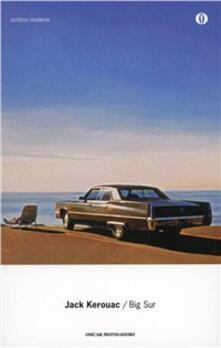 Big Sur
Big Sur

Nell'opera, scritta quando Kerouac è diventato ormai un popolare scrittore, è evidente il disagio dell'autore-protagonista sia nei confronti di un'immagine popolare che lo vorrebbe giovane, girovago e sregolato, sia delle sue stesse sregolatezze, alle quali cerca di sfuggire ma nelle quali ricadrà sempre. Come scrive Kerouac, in tutta l'America i giovincelli delle medie e dell'università pensano "Jack Duluoz ha ventisei anni e non fa che viaggiare con l'autostop", mentre eccomi qui quasi quarantenne, tediato e logoro sulla cuccetta di uno scompartimento riservato che corre rombando attraverso Salt Flat....
L'autobiograficità di Kerouac è inoltre confermata, oltre che dalla presenza di personaggi reali (sia pure nascosti dietro pseudonimi), anche dalle sue autocitazioni (in particolare di Sulla strada, il romanzo che lo ha reso famoso). Come in molte altre opere di Kerouac, inoltre, le sequenze narrative sono spesso celate dalle descrizioni degli stati d'animo e dalle riflessioni dello stesso protagonista.
|
|
Each book by Jack Kerouac in unique, a telepathic diamond. With prose set in the middle of his mind, he reveals consciousness itself in all its syntactic elaboration, detailing the luminous emptiness of his own paranoiac confusion. Such rich natural writing is nonpareil in later half xx-century, a synthesis of Proust, Céline, Thomas Wolfe, Hemingway, Genet, Thelonious Monk, Basho, Charlie Parker, and Kerouac’s own athletic sacred insight.
Big Sur’s a humane, precise account of the extraordinary ravages of alcohol delirium tremens on Kerouac, a superior novelist who had strength to complete his poetic narrative, a task few scribes so afflicted have accomplished—others crack up. Here we meet San Francisco’s poets & recognize hero Dean Moriarty ten years after On the Road. Jack Kerouac was a ‘writer,’ as his great peer W.S. Burroughs says, and here at the peak of his suffering humorous genius he wrote through his misery to end with ‘Sea,’ a brilliant poem appended, on the hallucinatory Sounds of the Pacific Ocean at Big Sur.' . Allen Ginsberg
Jack Kerouac was born in Lowell, Massachusetts, in 1922, the youngest of three children in a Franco-American family. He attended local Catholic and public schools and won a football scholarship to Columbia University in New York City, where he first met Neal Cassady, Allen Ginsberg, and William S. Burroughs. He quit school in his sophomore year after a dispute with his football coach. In 1947, enthused by bebop, the rebel attitude of his friends and the throng of hobos, drug addicts and hustlers he encountered in New York, he decided to discover America and hitchhike across the country. His writing was openly autobiographical and he developed a style he referred to as 'spontaneous prose' which he used to record the experiences. His first novel, The Town and the City, appeared in 1950, but it was On the Road, first published in 1957 and memorializing his adventures with Neal Cassady, that epitomized to the world what became known as the Beat Generation, and made Kerouac one of the most controversial and best-known writers of his time. Publication of his many other books followed, among them The Dharma Bums, The Subterraneans, and Big Sur. He died in St. Petersburg, Florida, in 1969, at the age of forty-seven. |